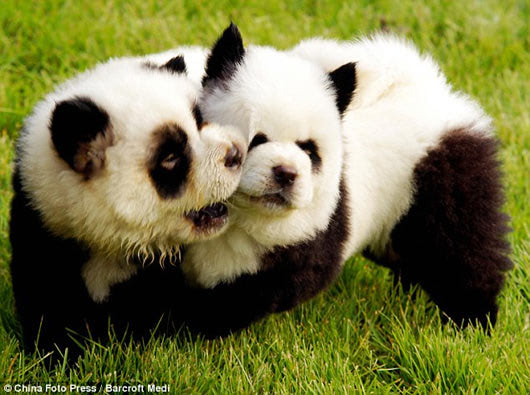As a child, I already saw some great tiger potential in my cat and some shark-ish attitude in the behaviour of my goldfish. Personally, I think that since we started domesticating animals, man must have had fantasies about undomesticating them. The thrill of making ‘man’s best friend’ into his enemy again – if only it where for one day: Back to the tribe!
The newest thing amongst dog owners in China seems to have emerged from this understandable fantasy and could be described as something like dog-modding: the color-dying of dogs, to make them look like other animals.
Like this retriever, that is painted like a tiger. However, more than convincing us that he really is a tiger, this seems to be a zoomorphic statement to remind us about our long lost direct relationship with the Wild. Cruel? Indignant? Funny? Fact is that recent figures show that money spent on pets across China has seen nearly a 500 per cent increase between 1999 and 2008.

Fake for Real: the Panda Dog
A more convincing example of dog-modding can be found in Wuhan, capital of the Hubei province, central China. A Chinese man modded his dog into a Panda – and did quite well so. As many will know, the Panda is a threatened animal, but also the national symbol of China. All living Panda’s in zoo’s all over the world are gifts from the Chinese government and are also considered state-property of the People’s Republic of China. The Panda es extremely popular in China – you could speak of a cult almost. But keeping a panda for yourself, of course, is strictly forbidden. So here the simulation comes in handy.
Mr Chang, the owner of this dog, said jokingly, “Panda is rare and none of us can own one privately, but we can make one for ourself”. Mr Chang has spent lots of time painting this dog and changing its flur ,which gives the dog a panda look. The dog is a Chow Chow, and is named “PanPan”. Should this be considered a shanzhai (counterfeit) version of the panda?
More than illustrating what bizarre strategies people have to turn their pets into a toys, this modifying of domesticated animals into look-a-like-wild-ones signifies how we have become completely disconnected from our natural environment, which in turn has been largely replaced by a world of design. There’s nothing my goldfish can do about that. Even if I would give it tiger-stripes.
In the end, the most radically domesticated animal is ourselves.

Via the Daily Mail.


Comments (0)
Share your thoughts and join the technology debate!
No comments yet
Be the first to share your thoughts!